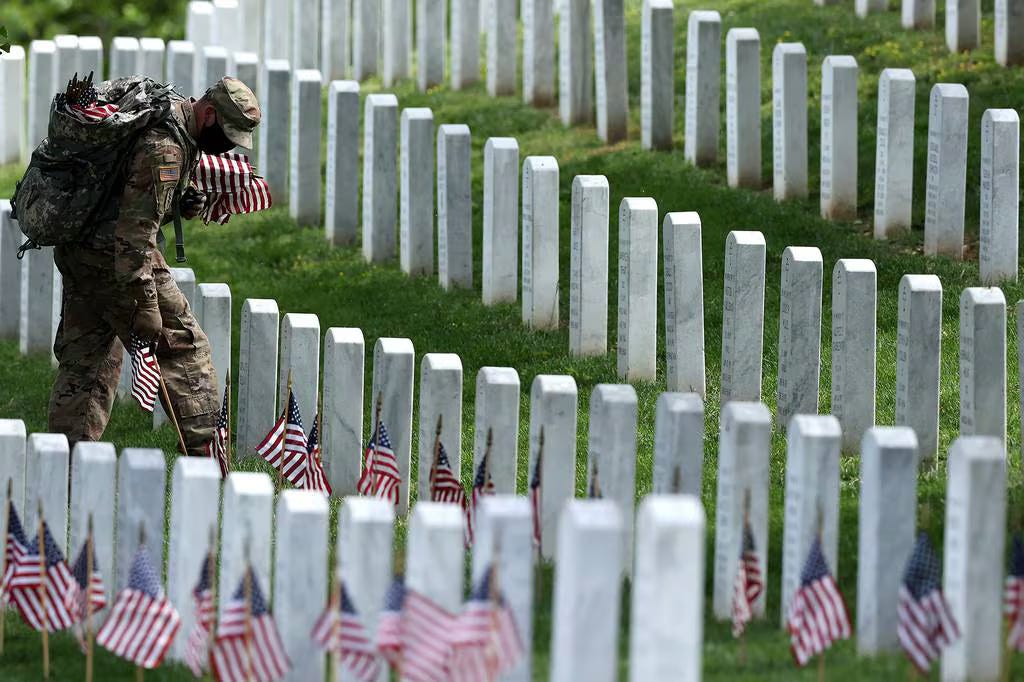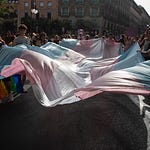For several years, as a young soldier, I took part in a special tradition for Memorial Day Weekend.
At the time, I was in the 3rd U.S. Infantry Regiment (The Old Guard), based in Washington, D.C. When our unit wasn’t doing tactical training, we were carrying out military funerals. Whenever you see photos or video of soldiers carrying flag-draped caskets in Arlington National Cemetery, that was my unit.
Every Thursday before Memorial Day Weekend, our company, which was the only one living on Ft. McNair in southwest D.C., would get up at 5:30am, get dressed in our duty uniform, and load up on buses with our empty rucksacks.
Upon arriving at Arlington, we’d stand in line waiting to fill our rucksacks with hundreds of standard miniature American flags, all rolled up in a bundle and bound together with rubber bands.
And then, for the rest of the day, until sundown, we’d walk along the sea of white headstones, laid out neatly as far as the eye can see, dress right dress, placing an American flag approximately a foot’s length in front of each one.
This tradition is called “Flags In,” and it’s, by far, my favorite memory during those years in uniform.
We had help. It wasn’t just The Old Guard. There were other units in the area who would pitch in. There were some civilian volunteers, too. Between all of us, working throughout the day, we’d get the job done, and by sunset, we’d be able to look upon the vast expanse of the Cemetery, seemingly infinite rows of American flags stretching into the horizon.
It was important to keep a good pace, of course. There are about 400,000 graves in Arlington for veterans and eligible family members, so you couldn’t take your time, but I’d try my best to read each name, at least, while placing a flag. It was my small way of honoring them.
There was one year I remember placing a flag and looking up at the headstone to read “Medgar W. Evers, Mississippi” and standing there for several moments in shock. I still get chills thinking about it. Who was I as some random, unproven 19 year-old private to have the honor of placing a flag on this hero’s grave?
But that’s Arlington. Buried alongside each other are privates and generals, senators and the formerly enslaved, retired soldiers who earned the right long before their final breaths many decades after their service and teenagers who earned the right before they were ever permitted to legally drink, all bound together in the same soil, under the same headstones, forever in formation and at peace.
There are some 639 acres of land covering the ANC divided into 70 sections. Every Memorial Day, I try to make it out to Section 60, where friends and people I admire are buried. That’s the section dedicated to those who died in the Global War on Terrorism.
There you’ll find my friend Joseph Hernandez, who was killed by a roadside bomb in Afghanistan in 2009. He became the first enlisted soldier to be buried in Arlington with full military honors under a then-recently-introduced regulation that accorded it to all service members killed-in-action. Prior to that, only officers were eligible for full honors.
Joe was the guy in my unit who always had a kind word for everyone. When I was a brand new private, he would check-in with me to see how things were going, always encouraging, always motivating, always with a smile and a joke to share. Before I knew anyone else in D.C., Joe was there to make me feel welcome.
I wish every American could visit Arlington at least once. I wish they could walk around on Memorial Day and pay their respects and see the friends and family who have made the trip just to sit around and share stories with each other.
Every year, especially in Section 60, I can always expect to see a group of friends who have brought chairs and sit around in front of their buddy’s grave, trading tales and remembering better times. I can expect to see widows and widowers bring flowers, holding their grown kids’ hands and reminding them why the ground they’re standing on is so special.
And I can expect to see more flags in one place than I’ll ever see anywhere else in my life, always placed a foot in front of each grave, always symbolizing so many things that I worry are increasingly becoming lost.
Maybe that worry is good. Maybe it’s necessary. If there isn’t concern over a lack of remembrance and respect, does complacency replace it? I think so. I think we need that constant reminder.
The Tuesday after Memorial Day, we’d get up again at 5:30am and load up on buses and make the trip back out to Arlington with our empty rucksacks for “Flags Out,” and we’d spend the entire day walking back along each grave and gently taking out each flag and bounding them together with rubber bands and by sunset, the whole Cemetery would be removed of flags.
We might whisper to each grave that we’d be back soon to remember them again.
And we’d mean it.












